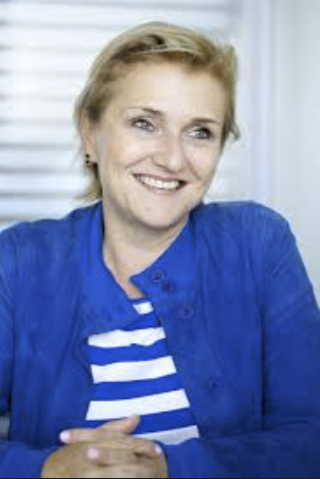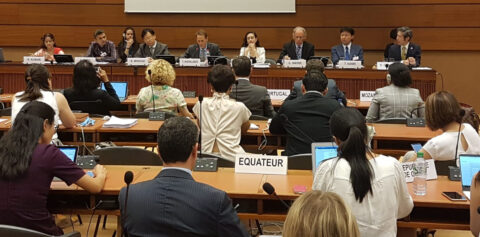
Meet Dr Ann Aerts, Head of the Novartis Foundation
Interviewed by Andie Tucker
from Global Partnership for Zero Leprosy Communications
Dr Ann Aerts leads the Novartis Foundation. She has been a catalyst in the formation of the Global Partnership for Zero Leprosy and a key adviser to the partnership. We spoke to her about the foundation’s contributions to innovations in the field of leprosy, and the steps needed to realize our goal of zero leprosy.
When did you first start working in the field of leprosy?
I started working in leprosy when I joined the foundation in 2013. Prior to joining the foundation, I had been working in several other infectious diseases and had particularly done a lot of work in tuberculosis, which is similar to leprosy given that they are both caused by Mycobacteria.
Why are you personally committed to working to the goal of zero leprosy?
Zero leprosy is a very compelling goal because, on the one hand, we know that we have reduced the problem by about 99% and we also know it is realistically feasible to get to zero leprosy, as we did so in most of the western world. Eliminating leprosy is a truly noble goal because this disease is so challenging, leaving people disabled for the rest of their life, even if they are cured from the infection. And such disabilities make life really difficult, because it still often leads to social exclusion. That is why I believe zero leprosy is what we have to aim for: not only as we have almost reached the goal, but also because it is proven to be feasible, even with the tools we have now, although some new tools may accelerate the process.
You personally were very engaged in creating this partnership. Why did the foundation feel that the creation of a partnership was necessary to reaching this goal of zero leprosy?
The launch of a Global Partnership for Zero Leprosy was absolutely necessary and I’m so happy that it came to fruition. When I joined the foundation I realised that, in contrast to most of the former global health partners I had been working with, like tuberculosis, malaria or AIDS, who were very much working together and aligned on their goals, the leprosy community was not aligned and working rather in independent ways. Each group had different agendas, and different funding streams, for different goals, without anyone bringing all these wonderful visions together. We need to reduce stigma and we still need to support rehabilitation of disabilities, but if we really want to eliminate leprosy, we have to align behind the single goal of interrupting transmission and prevent any further persons being affected by leprosy.
Declaring leprosy already eliminated as a public health problem, was shouting victory before its time, and that also posed a problem. It didn’t result in further reduction of the disease, and it merely eliminated interest and funding for leprosy, leaving a dissipated leprosy community. That’s when, six years ago, I set a goal for us at the foundation that we would work on interrupting transmission. The first thing we did to establish that new strategy was to bring all the leprosy experts together and ask the question, what should we do with the current tools we have to eliminate leprosy and which new tools should we start developing if we want to accelerate our goal? That meeting in 2013 was really crucial and built consensus around our 4 pillar strategy, including the need to translate evidence into practice (the reason behind our launch of the multi-country Leprosy Post-Exposure-Prophylaxis programme, LPEP), as well as the need to accelerate diagnosis of leprosy. Getting the whole community aligned behind that was truly nice.
What do you think are the most promising tools to help end leprosy?
I firmly believe that the most promising tool we have to fight leprosy and to achieve zero leprosy is early diagnosis and prompt treatment. The multidrug therapy and its widespread free availability for leprosy patients is the main tool we have to eliminate the disease, and it has proven to work very successfully in reducing the leprosy burden by 99%. To cover the last miles, it is however essential to do things differently as we saw the incidence, or new case detection rates, rather stagnating now over the past 10 years.
For me, the main aspect we have to change is the way we diagnose leprosy. Currently diagnosis is mainly based on symptoms, meaning that a skilled health professional is needed. That is a major obstacle, because there’s an enormous shortage of health care personnel in the world, and also leprosy expertise has largely disappeared since the disease has become so rare. We have to facilitate diagnosis, and that’s why we set out here at the foundation to develop a state-of-the-art diagnostic test where we can really have an objective diagnosis. We won’t get there perfectly at first, but we have some great starts.
A video from Microsoft about the development of a diagnostic tool, created in collaboration with the Novartis Foundation, uses AI and cellular technology to accelerate leprosy diagnosis.
Secondly, we set out to accelerate diagnosis with the main transformative tool we have currently at our fingertips, which is digital technology. Using digital health to diagnose leprosy with images, augmenting that with artificial intelligence (AI), will hopefully significantly help to accelerate diagnosis. If people can understand the probability of having a leprosy diagnosis themselves, thanks to an easily accessible digital tool, it will eventually accelerate the start of treatment and decrease stigma for patients, accelerating PEP for contact persons. This can make the path to cover these last miles very different.
We validated a digital image tool in the Philippines, where images are sent to a reference dermatologist or neurologist, for their opinion on whether the pictured skin lesion can be leprosy, and whether the patient should be referred for treatment. That image recognition can now be augmented with AI, so we are building the proof-of-concept for such a diagnosis accelerator with Microsoft. I hope this will become successful, but it’s also not a given yet, as building this is not so easy. We will however be very happy when we can make this available at large.
Finally, the most powerful tool we have is the treatment for leprosy. It doesn’t make sense to accelerate diagnosis without having an efficient treatment.
What other ways has the Novartis Foundation supported innovation in the leprosy field?
LPEP, the Leporsy Post-Exposure Prophylaxis Programme, is a great example how, in an innovative way, many partners pulled in the same direction, giving hope to patients and people affected. In 2013, we started LPEP throughout eight countries, based on evidence from a randomised control trial that you can administer a very simple preventative treatment with a single dose of one of the three leprosy treatment drugs in MDT: Rifampicin. Single-dose rifampicin can prevent the disease among close contacts of persons of recently diagnosed with leprosy in more than 50% of cases. The Novartis Foundation committed itself to demonstrate to the world that it is feasible and that it can curb the incidence downwards again. For more than ten years, we saw the stagnation of 200,000 to 250,000 newly diagnosed patients each year, while everybody was waiting for the elimination to happen by itself. With the implementation of LPEP, which was a massive investment for the Novartis foundation, leprosy post-exposure prophylaxis was proven successful.
The second innovation we’ve brought to the field is preclinical validation of a molecular diagnostic test. This digital image recognition tool using AI is an innovation we have spurred together with Microsoft that we are going to make into a way to accelerate diagnosis.
As explained before, probably the most important innovation taking a new collaborative approach is the Global Partnership for Zero Leprosy. I feel the Global Partnership is bringing the agenda forward. This is the momentum we need to see happening, and now is the right time for the Novartis Foundation to support phasing out of leprosy. The Novartis company will continue working with the leprosy community, and the Novartis Foundation is going to focus on new activities. Clearly, as a doctor, the fight against leprosy will stay close to my heart always.
Your vision and foresight helped to create the partnership. What are your hopes for the work the partnership leads in the future, and what would you like to see happen in the world of leprosy?
My main hope for the Global Partnership and the whole leprosy community is that they can declare leprosy eliminated at a certain point in the future. That will not happen next year, but if we all work together and keep to an aligned agenda of implementing evidence, we will get there.
Reposted with permission from The Global Partnership for Zero Leprosy – originally published 6 June 2019 here.






